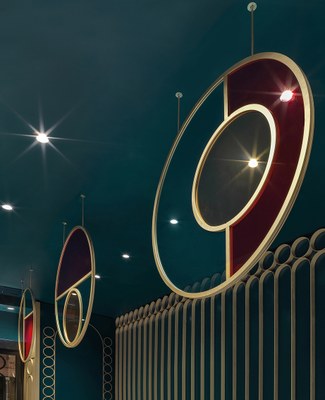An idea for luxury hospitality, an opportunity for Rome. Emidio Pacini, his brother Fabrizio, and Andrea Girolami are the Roman entrepreneurs and owners of the Tridente Collection who supervised the regeneration and revalorization of the entire area spurred by the construction of the Palazzo Navona hotel and the redevelopment of via del Melone.
The last step is the opening of LIÒN, the new restaurant and cocktail bar located in the heart of Rome, halfway between the Pantheon and Piazza Navona, and designed by the architect Daniela Colli (COLLIDANIELARCHITETTO) to create a sophisticated place with soft lights, mirrored surfaces and a pleasant terrace; in addition, the project is part of a historical building from the Rationalist era, where the bold lines and the saturated colours in maximalist style contrast with the austerity of the Palazzo that encompassed it.
LIÒN unfolds on two levels: the ground floor, encapsulating the restaurant is completely projected on the outside through large windows outlined by a thick travertine frame, which are a signature element of Rationalist architecture; the basement, which is accessed via a marble staircase embellished with brass details, houses the service rooms, the kitchen and the wine cellar.
The circle is the matrix of the dynamic elements, with soft and sinuous lines, which characterize the interiors,from the subtle and arched friezes that envelop the space, to the deep three-dimensional lozenge screen of the lacquered ottoman, the colourful boiserie, and the curved supports that cradle the bottle holder suspended on the counter.
Custom-designed furniture, where form and function intertwine, such as the cutlery drawers or the menu compartments decorated with metallic details, are distinguished by their pop aesthetic, in which the circle remains the protagonist.
Moreover, slender metal structures frame colourful transparent elements, such as discs suspended above the black marble tables or the lozenge elements of the bottle rack above the counter, giving rise to a formal ethereal vocabulary with a contemporary flavour.
The use of coloured tinted glass for the architectural decorative elements is a contemporary reinterpretation of the leaded glass quintessential to the early Twentieth century; the choice of essential geometries and the use of primary colours are inspired by Wright’s research on the dynamic relationship between light screens and continuous, fluid interior spaces.
The large columns covered in mosaic pierce the long counter with a turquoise diamond glass coating where, on a thick milled brass top, nimble bar tenders mix their cocktails.
The use of colour is meticulously modulated: teal, turquoise, red dominate the space and furnishings, from velvet chairs to the continuous sofa with its enveloping shapes, generating a harmonious set of micro and macro elements that compose the project.
In conclusion, the refinement of shapes and proportions delivers an eclectic and innovative, informal yet elegant environment, where clients can take a break in style and enjoy Rome’s atmosphere.
















